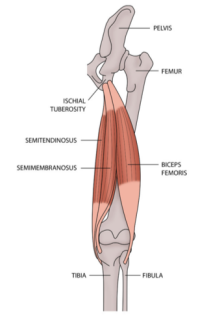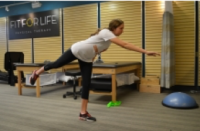Hamstrings 201 - The Advanced Course
Fit For Life Physical Therapy
Those long Saturday training runs are getting longer. That goal race is getting a bit closer. However, a nagging pull in the back of your thigh is not something to overlook. Your hamstring muscles may be trying to tell you something.
The hamstrings are an important muscle group when it comes to running. The main function of the hamstrings is to bend the knee and extend the hip. In running, the hamstrings act as a propeller to move your body forward. When the hamstrings are unable to fully do their job, they can be susceptible to injury. But, before we talk about hamstring injuries, it is important to first understand their anatomy.

Anatomy
The hamstrings are a group of three muscles located on the back of your thigh. All three of the muscles originate at one of the ischial tuberosities which are also known as your “sit bones,” as these are the bony prominences that you feel when you are sitting. The semitendinosus and semimembranosus muscles insert on the inside of the knee (medial condyle of tibia), while the biceps femoris inserts on the outside of the knee (lateral head of fibula).
Injury
There are a wide variety of hamstring injuries that differ by severity, location, and symptoms. Symptoms of a hamstring injury may include pain on the back of the thigh, lower buttock, or behind the knee; tightness in the back of the thigh; a sudden “pop” while running; and bruising or tenderness. The most common hamstring injury among distance runners is a proximal hamstring strain, which is located on or near the origin of the hamstrings at the ischial tuberosity. Unfortunately, proximal hamstring strains can take a long time to heal. However, modalities, strengthening, and stretching can help improve symptoms and keep you on the road, trail, or treadmill.
Prevention
Hamstring tightness is one of the main factors in hamstring injuries, either as a cause or a result of an injury. One way to prevent hamstring injuries is to stretch your hamstrings after your dynamic warm-up, but prior to running. This will allow the muscle to warm and loosen up before being worked.
To perform a hamstring stretch, lay on your back. Grab behind your thigh and bring your leg towards your chest, as pictured to the right. Then, slowly straighten your knee until you feel a stretch in the back of your thigh. When you feel the stretch, hold the position for 10 seconds. Relax, by bending the knee, then perform that same stretch 9 more times. Repeat on the other leg.
Hamstring weakness is another factor in hamstring injuries. As our Medical Director, Dr. Darrin Bright, often says, when there are strength imbalances in the body, the body will not be able to mechanically work the way it should. When muscles are strengthened and balanced, the body will be able to run more efficiently.
One example of a hamstring strengthening exercise is “grab-a-pens.” To perform, place a target, such as a pen, on the floor. Stand a couple feet behind the pen, as pictured on the left. Then, balance on one leg and place the opposite arm straight up in the air. Slowly bend forward on the standing leg while keeping the knee straight. Bend towards your target, trying to grab the pen, until you can’t go any further, or until you are about to lose your balance. Then slowly come back up. It is important to take your time going in both directions, as this exercise strengthens the hamstrings concentrically and eccentrically.

Contact Fit For Life Physical Therapy at (614) 981-1979 or www.fitforlifephysicaltherapy.com if you have any questions about hamstring anatomy, injuries, stretching, or strengthening. Fit For Life Physical Therapy is proud to be the official, exclusive MIT and Fleet Feet sports medicine partner. We will keep you moving – no matter what you do.
Connect With Us
See the latest from Fleet Feet Columbus